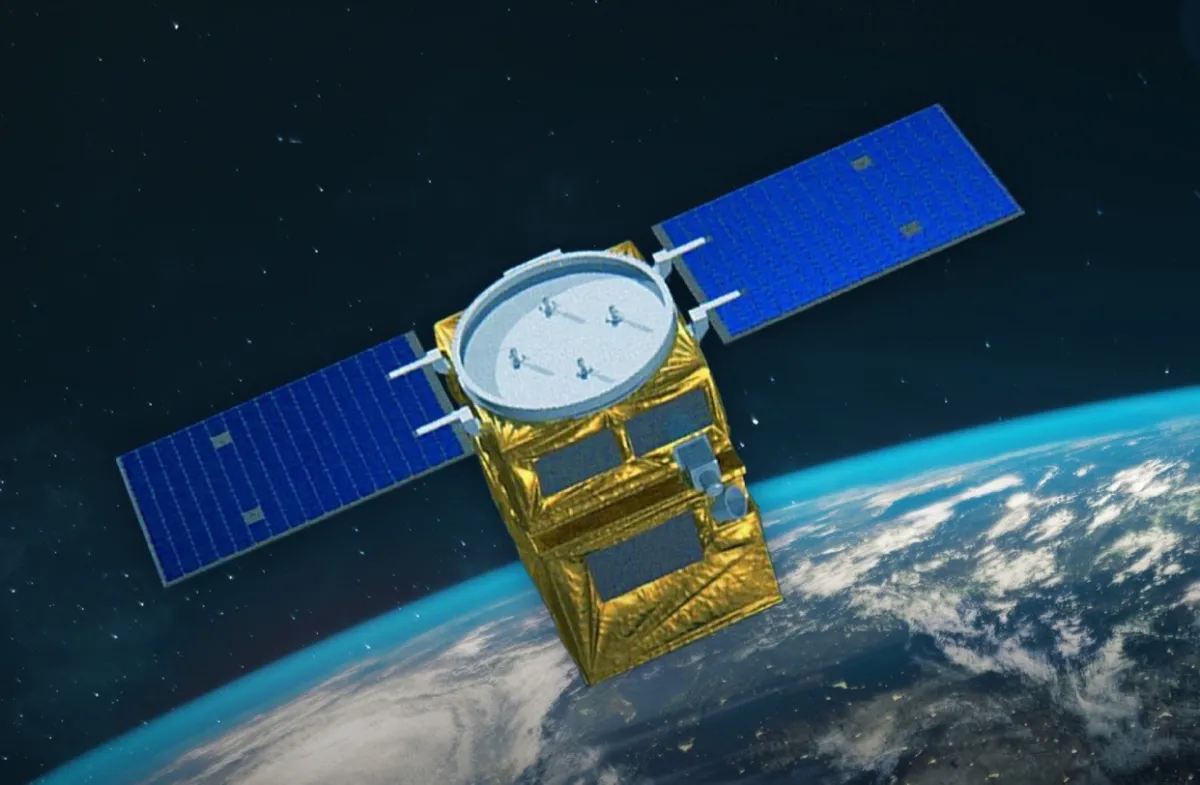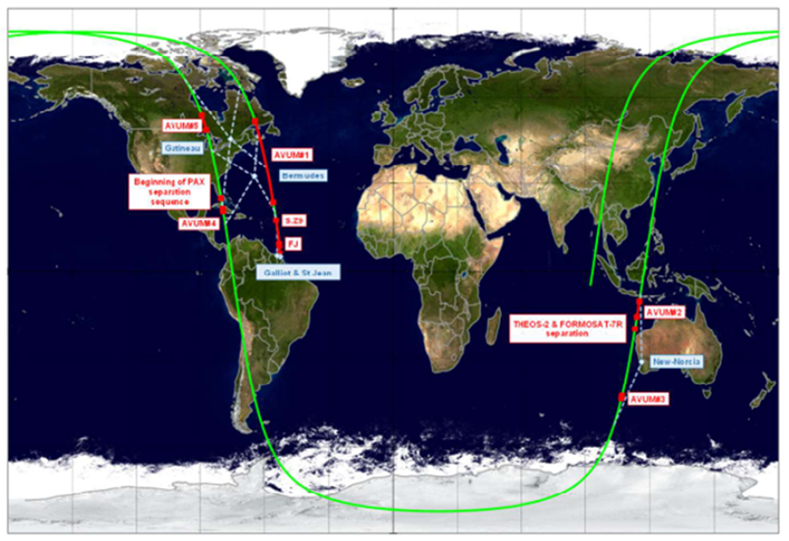
THEOS-2 satellite is scheduled for launch on October 7, at approximately 08:36 Thailand time (01:36 UTC/ 22:36 Kourou) by a VEGA launch vehicle from the Guiana Space Centre launch pad (located at Latitude 3 degrees north of Equator) in French Guiana, South America. The mentioned launch pad belongs to the Arianespace Company.
This launch is the 23rd flight of the VEGA launch vehicle, with the THEOS-2 satellite as the Primary payload, the Formosat-7R satellite as the Secondary payload, and the Auxiliary payload consisting of 10 maximum 100 kilograms satellites.
The launch of the rocket will occur at approximately 8:36 a.m. Thailand time on October 5th. The launch trajectory will be northward. Since THEOS-2 will be launched into Polar orbit which the direction must be north or south, but the Guiana Space Center's launch pad is in the north of Brazil. Therefore, the rocket cannot travel south over Brazil for safety reasons.
In this regard, the rocket must be launched in a direction consistent with satellite orbit. The THEOS-2 satellite orbit is Sun Synchronous and travels from the South up to the North Pole at night. Accordingly, the rocket must be dispatched during nighttime. (Local time at launch base)
Within 7 minutes after firing the rocket, the propellant stages 1, 2, and 3 are used up and detached from the main stage of the rocket. At the rocket head, two fairings are separated consequently. The first stage, second stage, and the fairings will fall back to Earth in the Atlantic Ocean. Then the third stage of the rocket will reentry in the Arctic Ocean. The remaining main part of VEGA consists of the Upper Stage, Payload Adapter, and all 12 Payloads. (Primary, Secondary and 10 Auxiliary)

The VEGA launch vehicle will orbit pass over the North Pole, then separate THEOS-2 satellite at orbit position slightly below the equator at approximately 9:31 a.m. Thailand time. The separation will occur at 600 kilometers altitude. (Lower than the desired orbit of 621 kilometers). THEOS-2 satellite and the Formosat-7R satellite will be detached simultaneously. After that the rocket will transfer to a lower orbit in order to launch the remaining 10 Auxiliary payload satellites.
Regarding THEOS-2 satellite, after the system detects the separation from the rocket, the On-Board Computer (OBC) will command the solar arrays deployment. Then the Attitude and Orbit Control system (AOCS) will reduce the tumbling rate of satellite, which is the multi-directional rotation caused by forces during separation. (The separation is done by 6 separation springs.) This phase is called De-Tumbling. After lowering the rotation rate to a threshold, the satellite will perform Sun Acquisition phase to seek the sun and point the Solar panels towards the sun for charging the battery.
Thanks to the control algorithm, the satellite will be in SAFE Mode and will turn on only necessary devices that are sufficient for basic operation and wait for further commands from the Ground segment. THEOS-2 will orbit pass over the Sri Racha ground station for the first time at approximately 10:53 a.m. local time.

Launch and Early Operation Phase (LEOP) and In-Orbit Test (IOT) activities.
LEOP (Launch and Early Operational Phase) is the Operational activities that occur starting a few hours before launch and finishing when the satellite is placed in the operational orbit.
• Checking and confirming the readiness of ground and satellite systems to approve Go/No Go for launch.
• Confirmation of separation from launch vehicle
• First contact with satellite.
• Confirmation of Solar panel deployment status, De-tumbling status, etc.
• Sending commands to turn on the normal operation devices and transfer the satellite mode out of SAFE Mode.
• Checking the operation status of various systems (AOCS, Power, Thermal, RF).
• Sending commands to perform thruster calibration and orbit transfer
• Turning on the payload instruments and changing the satellite into Operation Mode.
• Taking the first image to check the Payload (Instrument + X-Band Transmitter)
• In normal situation, LEOP activities take 5-10 days depending on the orbit adjustment from Injection to Operational orbit
LEOP rehearsal at Sriracha Ground Control Station by AIRBUS team staffs IOT (In-Orbit Testing) is the consequence activities after LEOP with the objectives of:
• Test the satellite functions as designed comparing parameters between the actual and the calculated/predicted as well as perform the adjustment if necessary.
• Test system performance for both satellite and ground systems e.g., the manoeuvre time for imaging, image data transmission to the ground system, the number of image data received and the number of products each day, et cetera.
• Adjusting the parameters of Payload instrument e.g., image sharpness, Noise level, et cetera to be ready for the imaging operation serving Thailand and global.
.png)
THEOS-2 Specifications.
THEOS-2 satellite is classified as “High Resolution Earth observation satellite” which can acquire satellite image of objects larger than 50x50 centimeters on the earth.
Presently, the manufacturing processes of THEOS-2 both space segment and ground segment have been totally accomplished e.g., Assembly, Integration and testing, Satellite validation, System validation, et cetera.THEOS-2 satellite is now arrived at the launch facility, French Guiana for the launch readiness processes and wait for being launched soon.
THEOS-2 system leads to satellite image production and Geo-informatics service enhancement, IT infrastructure improvement. It also accelerates the expansion of the industrial sector in capacity building and space technology services. These will ensure the continuity of space technology and Geo-informatics in the country. As well as THEOS-2 will secure the space mission of Thailand in replace of THAICHOTE satellite mission that will be completed soon.
THEOS-2 satellite's Specification
• Sun Synchronous Orbit
• Altitude: 621 kilometers (Repeat cycle: 26 days)
• Global accessible coverage.
• Spatial resolution (GSD): 2 meters for Multispectral / 50 centimeters for Panchromatic
• Value added product: High resolution 50 centimeters image (Pan Sharpening)
• Revisit time: 4 days at 45 degrees roll angle.
• Swath width: 10.3 kilometers.
• Imaging Capacity: >74,000 square kilometers/day.
• Memory: 1 Tera bits
• Mass: 425 kilograms, Minimum designed lifetime: 10 years.
• Planned launch: Late 2023 using the VEGA Launcher at the Guiana Space Center in Kourou, French Guiana, South America.
Cr. https://www.gistda.or.th/theos2/